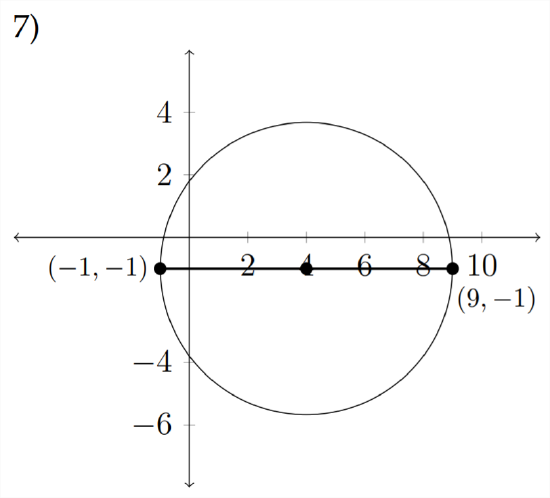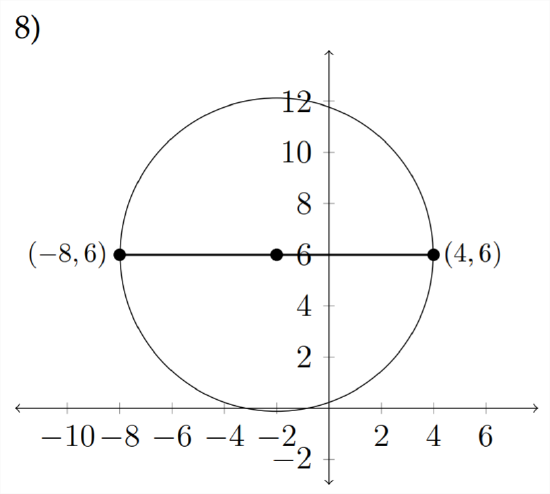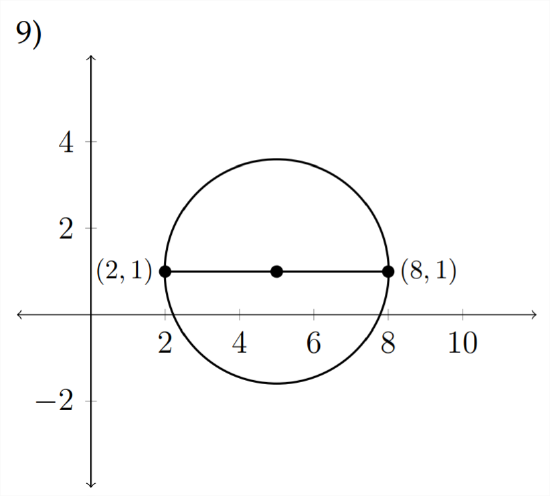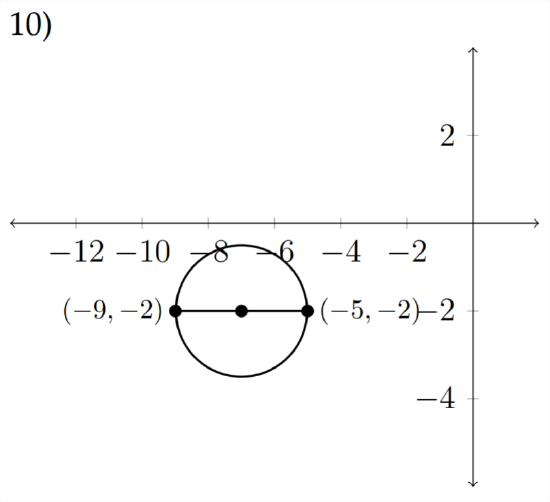5.1: The Equation of the Circle
- Page ID
- 40924
The equation for a circle is typically given as:
\[ (x-h)^{2}+(y-k)^{2}=r^{2}
\] In this equation, the point \((h, k)\) represents the center of the circle and \(r\) represents the radius of the circle. This equation is derived from the distance formula. The definition of a circle is the locus (or collection) of points that are equidistant from a given point (the center of the circle).
So, taking this definition, we can say that any point \((x, y)\) that is on the circle should be a distance of \(r\) from the center. Using the distance formula:
\[ d=\sqrt{\left(x_{1}-x_{2}\right)^{2}+\left(y_{1}-y_{2}\right)^{2}}
\] Squaring both sides:
\[ d^{2}=\left(x_{1}-x_{2}\right)^{2}+\left(y_{1}-y_{2}\right)^{2}
\] In this situation, the distance \(d\) is the radius of the circle, \(r .\) This distance should be the same for all points on the circle. So any point on the edge of the circle, \((x, y)\) should be a distance of \(r\) from the center of the circle, \((h, k)\)
\[ (x-h)^{2}+(y-k)^{2}=r^{2}
\]
Exercises \(\PageIndex{1}\)
Determine the center and radius for each circle and sketch the graph of the circle.
1) \(\quad(x-3)^{2}+(y+1)^{2}=9\)
2) \(\quad(x+4)^{2}+(y+2)^{2}=16\)
3) \(\quad(x-1)^{2}+(y-6)^{2}=20\)
4) \(\quad(x-2)^{2}+(y+5)^{2}=27\)
5) \(\quad(x+7)^{2}+(y-4)^{2}=33\)
6) \(\quad(x-5)^{2}+(y-3)^{2}=50\)
Determine the equation for each circle. Each line represents a diameter




Sometimes the equation for a circle is not given in the standard form. In this situation, you need to put the equation into standard form and then determine the center and radius. In order to put the equation into standard form you will need to complete the square. Completing the square is a mathematical technique that is often useful and is the basis for how the quadratic formula is derived.
Suppose that we are given the equation of a circle that is not in standard form:
\[ x^{2}+6 x+y^{2}+10 y+25=0\]
We need to restate this relationship so that the center and radius can be easily determined from the equation. In order to do this, we need to complete the square for both the \(x\) and the \(y\) variables. There are a variety of methods for completing the square I will demonstrate one of these below.
Take the original equation and move any term that doesn't have a variable to the other side:
\[ x^{2}+6 x+y^{2}+10 y=-25\]
Then open a space after the \(6 x\) and the \(10 y:\)
\[ x^{2}+6 x+y^{2}+10 y=-25\]
The idea is that we want trinomial expressions for both \(x\) and \(y\) that are perfect squares.
If we look at squaring binomial expressions, we can see that there is a pattern:
\begin{array}{l}
(x+3)^{2}=(x+3)(x+3)=x^{2}+6 x+9 \\
(x+4)^{2}=(x+4)(x+4)=x^{2}+8 x+16 \\
(x+5)^{2}=(x+5)(x+5)=x^{2}+10 x+25 \\
(x+6)^{2}=(x+6)(x+6)=x^{2}+12 x+36
\end{array}
We can see that if we have \(x^{2}+6 x,\) then this would correspond to \((x+3)(x+3)\) or \((x+3)^{2}\). But there's a problem: \((x+3)^{2}\) is not equal to \(x^{2}+6 x\). It's equal to \(x^{2}+6 x+9 .\) We can't just add a 9 to the \(x^{2}+6 x,\) but we can add a 9 to both sides.
\[ x^{2}+6 x+9+y^{2}+10 y=-25+9\]
Similarly, to complete the square on the \(y,\) we see that \(y^{2}+10 y\) corresponds to \((x+5)(x+5)\) or \((x+5)^{2}\). Here, we would need to add 25 to both sides to create a perfect square.
\[ \begin{aligned}
x^{2}+6 x+9+y^{2}+10 y+25 &=-25+9+25 \\
x^{2}+6 x+9+y^{2}+10 y+25 &=9 \\
(x+3)^{2}+(y+5)^{2} &=9
\end{aligned}
\]
So, the center of the circle is (-3,-5) and the radius is 3
Sometimes it is not so obvious what the values of \(h\) and \(k\) should be in completing the square. Consider the equation below:
\[ x^{2}+20 x+y^{2}+30 y+15=0
\] If we look back at the examples for squaring binomials, we can see the pattern that relates the coefficient of the linear term to the values for \(h\) and \(k\)
\[ \begin{array}{l}
(x+3)^{2}=(x+3)(x+3)=x^{2}+6 x+9 \\
(x+4)^{2}=(x+4)(x+4)=x^{2}+8 x+16 \\
(x+5)^{2}=(x+5)(x+5)=x^{2}+10 x+25 \\
(x+6)^{2}=(x+6)(x+6)=x^{2}+12 x+36
\end{array}
\] Notice that the coefficient of the linear term is always double the value of the numeral in the parentheses and the constant term is always that number squared.
\[ (x+n)^{2}=(x+n)(x+n)=x^{2}+2 n x+n^{2}
\] So, given the problem above, \(x^{2}+20 x+y^{2}+30 y+15=0,\) first we can move the
15 to the right hand side of the equation and then complete the squares on the \(x\) and \(y\) variables.
\[ \begin{array}{c}
x^{2}+20 x+y^{2}+30 y=-15 \\
(x+?)^{2}+(y+?)^{2} \\
x^{2}+20 x+100+y^{2}+30 y+225=-15+100+225 \\
(x+10)^{2}+(y+15)^{2}=310
\end{array}
\] We can now see that the center of the circle is at the point (-10,-15) and the radius of the circle is \(\sqrt{310} \approx 17.6\)
Exercises \(\PageIndex{2}\)
Find the center and radius for each circle.
If the equation is not written in standard form, complete the square to rewrite the equation in standard form: \((x-h)^{2}+(y-k)^{2}=r^{2}\)
- \(\quad x^{2}+y^{2}=4\)
- 2) \(\quad x^{2}+(y-1)^{2}=1\)
- 3) \(\quad 2(x-3)^{2}+2 y^{2}=8\)
- 4) \(\quad 3(x+1)^{2}+3(y-1)^{2}=6\)
- 5) \(\quad x^{2}+y^{2}-2 x-4 y-4=0\)
- 6) \(\quad x^{2}+y^{2}+4 x+2 y-20=0\)
- 7) \(\quad x^{2}+y^{2}+4 x-4 y-1=0\)
- 8) \(\quad x^{2}+y^{2}-6 x+2 y+9=0\)
- 9) \(\quad 2 x^{2}+2 y^{2}+8 x+7=0\)
- 10) \(\quad 3 x^{2}+3 y^{2}-12 y=0\)
- 11) \(\quad 2 x^{2}+2 y^{2}-12 x+8 y-24=0\)
- 12) \(\quad 2 x^{2}+8 x+2 y^{2}=0\)
- 13) \(\quad x^{2}+y^{2}+15 x=0\)
- 14) \(\quad x^{2}+y^{2}+x+y-\frac{1}{2}=0\)
- 15) \(\quad x^{2}+y^{2}-x+2 y+1=0\)
- 16) \(\quad 3 x^{2}+3 y^{2}-6 x+3 y=4\)
- 17) \(\quad 2 x^{2}+2 y^{2}-10 x-18 y=1\)
- 18) \(\quad 2 x^{2}+2 y^{2}-5 x+y=0\)
- 19) \(\quad 9 x^{2}+9 y^{2}+9 x-27 y+1=0\)
- 20) \(\quad 2 x^{2}+2 y^{2}-7 x+y=0\)


